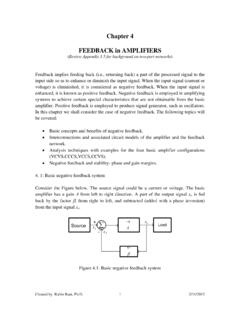Transcription of DEVELOPMENTAL SEQUENCE IN SMALL GROUPS
1 Psychological Bulletin1965, Vol. 63, No. 6, 384-399 DEVELOPMENTAL SEQUENCE IN SMALL GROUPS1 BRUCE W. TUCKMANN aval Medical Research Institute, Bethesda, Maryland50 articles dealing with stages of group development over time are separated bygroup setting, as follows: therapy-group studies, T-group studies, and natural-and laboratory-group studies. The stages identified in these articles are separatedinto those descriptive of social or interpersonal group activities and thosedescriptive of group-task activities. Finally, 4 general stages of developmentare proposed, and the review consists of fitting the stages identified in theliterature to those proposed. In the social realm, these stages in the develop-mental SEQUENCE are testing-dependence, conflict, cohesion, and functional the task realm, they are orientation, emotionality, relevant opinion exchange,and the emergence of solutions.
2 There is a good fit between observed stages andthe proposed model. Further study of temporal change as a dependent variablevia the manipulation of specific independent variables is purpose of this article is to review theliterature dealing with the devlopmentalsequence in SMALL GROUPS , to evaluate thisliterature as a body, to extrapolate generalconcepts about group development, and tosuggest fruitful areas for further SMALL -group processes have beengiven great attention in recent years by be-havioral scientists, the question of change inprocess over time has been relatively neg-lected. Perhaps the major reason for this isthe overwhelming tendency of the SMALL -groupresearcher to run GROUPS for short periods oftime and thus avoid the "problems" createdby temporal change.
3 Laboratory studies ofdevelopmental phenomena are quite rare. Themajority of articles dealing with sequentialgroup development come from the group-therapy setting and human relations training-group setting, neither of which features strictexperimental control nor manipulation of in-dependent variables. Moreover, the only ma-jor theoretical statements of group develop-ment which have appeared are those of Bales(19S3), Schutz (1958), and Bach (1954).In an attempt to bring the facts and theissues into sharper focus, existing research in1 From Bureau of Medicine and Surgery, NavyDepartment, Research Task , Sub-task I. The opinions and statements contained hereinare the private ones of the writer and not to beconstrued as official or reflecting the views of theNavy Department or the naval service at author is grateful to Irwin Altman for his in-valuable ideas and suggestions, and to Robert Nyefor his efforts in helping to review the area of SMALL -group development will becited, and a framework within which this phe-nomenon can be better understood and fur-ther investigated will be presented.
4 Thisframework will also serve to integrate thevariety of studies cited in a meaningful MODELThe classification approach adopted for dis-tinguishing between and within developmentalstudies is a threefold one. The delineationsare based on (a) the setting in which thegroup is found, (b) the realm into which thegroup behavior falls at any point in time,that is, task or interpersonal, and (c) theposition of the group in a hypothetical de-velopmental SEQUENCE (referred to as the stageof development). It is this last delineationthat allows not only for the separation andordering of observations within each set-ting, but for the development of additionalhypotheses as according to setting allows forthe clustering of studies based on their simi-larity of features, for example, group size,group problem area, group composition, dura-tion of "group life," etc.
5 More similaritybetween observations made in the same set-ting than in different settings is the group-therapy setting the task is tohelp individuals better deal with their per-sonal problems. The goal is individual adjust-384 DEVELOPMENTAL SEQUENCE IN SMALL GROUPS385ment. Such GROUPS contain from 5 to ISmembers, each of whom has some debili-tating personal problem, and a therapist, andthe group exists for 3 months or more. Thedevelopmental data for such GROUPS consistof the observations of the therapist andthose professional observers that are present,usually as trainees. Such data are highlyanecdotal in nature and reflect the clinicalbiases of the observers. Furthermore, suchaccounts are usually formulated after the factand based on the observation of a singlegroup.
6 Since the bulk of the literature re-viewed comes from this setting, its generalitymust be limited by the limitations of thesetting and the mode of data the human relations training-group(T-group) setting, the task is to help indi-viduals interact with one another in a moreproductive, less defensive manner, and to beaware of the dynamics underlying such inter-action. The goal is interpersonal GROUPS contain ordinarily from IS to30 members, usually students or corporationexecutives, and one trainer or leader, andendure from about 3 weeks to 6 most striking differences betweentherapy- and training-group settings are inthe areas of group composition, task, goal, andduration of group life.
7 Such differences canaccount for different findings in the two set-tings. The most striking similarity is in themanner of data collection. Data in thetraining-group setting are highly anecdotal,subjective, collected by the trainer and hisco-workers, and often based on the observa-tions of a single group. Again, this serves tolimit the generality of these natural-group setting is distinguishedon the basis that the group exists to performsome social or professional function overwhich the researcher has no control. Membersare not brought together for self-improve-ment; rather, they come together to do a GROUPS may be characterized either byappointed or emergent leadership. Presidentialadvisory councils and industrial GROUPS repre-sent examples of natural GROUPS .
8 Similar limi-tations to generalization based on the mannerof data collection and number of GROUPS ob-served applies in this setting as in the laboratory-task setting features groupsbrought together for the purpose of studyinggroup phenomena. Such GROUPS are SMALL (gen-erally under 10 members), have a short life,and may or may not have leaders. In this set-ting, GROUPS are given a task or tasks whichthey are to complete. Quantitative data arecollected and analyzed based on multiple-group last two settings have been combineddue to the SMALL number of studies in each(the dearth of group development studies inthe industrial area is notable), and also be-cause theoretical statements are reviewedwhich are generalized to cover both areas.
9 Allstudies will be classified into one of the threesetting categories according to best : Interpersonal versus TaskWithin the studies reviewed, an attempt willbe made to distinguish between interpersonalstages of group development and task be-haviors exhibited in the group. The contentionis that any group, regardless of setting, mustaddress itself to the successful completion ofa task. At the same time, and often throughthe same behaviors, group members will berelating to one another interpersonally. Thepattern of interpersonal relationships is re-ferred to as group structure and is interpretedas the interpersonal configuration and inter-personal behaviors of the group at a point intime, that is, the way the members act andrelate to one another as persons.
10 The contentof interaction as related to the task at handis referred to as task activity. The proposeddistinction between the group as a social en-tity and the group as a task entity is similarto the distinction between the task-orientedfunctions of GROUPS and the social-emotional-integrative functions of GROUPS , both of whichoccur as simultaneous aspects of group func-tioning (Bales, 19S3; Coffey, 1952; Deutsch,1949; Jennings, 1947).In therapy GROUPS and T GROUPS , the task isa personal and interpersonal one in that thegroup exists to help the individuals deal withthemselves and others. This makes the inter-personal-task distinction a fuzzy one. A fur-ther problem with this distinction occurs be-cause the studies cited do not distinguish be-tween the two realms and often talk about386 BRUCE W.














